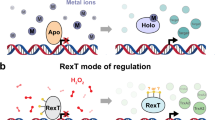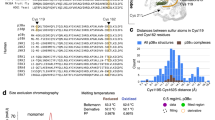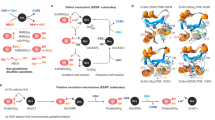Abstract
The Escherichia coli OxyR transcription factor is activated by cellular hydrogen peroxide through the oxidation of reactive cysteines. Although there is substantial evidence for specific disulfide bond formation in the oxidative activation of OxyR, the presence of the disulfide bond has remained controversial. By mass spectrometry analyses and in vivo labeling assays we found that oxidation of OxyR in the formation of a specific disulfide bond between Cys199 and Cys208 in the wild-type protein. In addition, using time-resolved kinetic analyses, we determined that OxyR activation occurs at a rate of 9.7 s−1. The disulfide bond–mediated conformation switch results in a metastable form that is locally strained by ∼3 kcal mol−1. On the basis of these observations we conclude that OxyR activation requires specific disulfide bond formation and that the rapid kinetic reaction path and conformation strain, respectively, drive the oxidation and reduction of OxyR.
This is a preview of subscription content, access via your institution
Access options
Subscribe to this journal
Receive 12 print issues and online access
$189.00 per year
only $15.75 per issue
Buy this article
- Purchase on Springer Link
- Instant access to full article PDF
Prices may be subject to local taxes which are calculated during checkout







Similar content being viewed by others
References
Halliwell, B. & Gutteridge, J.M.C. Free Radicals in Biology and Medicine Oxford University Press, New York (1999).
Lander, H.M. An essential role for free radicals and derived species in signal transduction. FASEB J. 11, 118–124 (1997).
Storz, G., Tartaglia, L.A. & Ames, B.N. Transcriptional regulator of oxidative stress-inducible genes: direct activation by oxidation. Science 248, 189–194 (1990).
Zheng, M., Aslund, F. & Storz, G. Activation of the OxyR transcription factor by reversible disulfide bond formation. Science 279, 1718–1721 (1998).
Hausladen, A. et al. Nitrosative stress: activation of the transcription factor OxyR. Cell 86, 719–729 (1996).
Kullik, I., Toledano, M.B., Tartaglia, L.A. & Storz, G. Mutational analysis of the redox-sensitive transcriptional regulator OxyR: regions important for oxidation and transcriptional activation. J. Bacteriol. 177, 1275–1284 (1995).
Tao, K., Fujita, N. & Ishihama, A. Involvement of the RNA polymerase alpha subunit C-terminal region in co-operative interaction and transcriptional activation with OxyR protein. Mol. Microbiol. 7, 859–864 (1993).
Toledano, M.B. et al. Redox-dependent shift of OxyR-DNA contacts along an extended DNA-binding site: a mechanism for differential promoter selection. Cell 78, 897–909 (1994).
Aslund, F., Zheng, M., Beckwith, J. & Storz, G. Regulation of the OxyR transcription factor by hydrogen peroxide and the cellular thiol-disulfide status. Proc. Natl. Acad. Sci. USA 96, 6161–6165 (1999).
Tao, K. In vivo oxidation-reduction kinetics of OxyR, the transcriptional activator for an oxidative stress-inducible regulon in Escherichia coli. FEBS Lett. 457, 90–92 (1999).
Choi, H. et al. Structural basis of the redox switch in the OxyR transcription factor. Cell 105, 103–113 (2001).
Kim, S.O. et al. OxyR: a molecular code for redox-related signaling. Cell 109, 383–396 (2002).
Zaim, J. & Kierzek, A.M. The structure of full-length LysR-type transcriptional regulators. Modeling of the full-length OxyR transcription factor dimer. Nucleic Acids Res. 31, 1444–1454 (2003).
Ellis, H.R. & Poole, L.B. Novel application of 7-chloro-4-nitrobenzo-2-oxa-1,3-diazole to identify cysteine sulfenic acid in the AhpC component of alkyl hydroperoxide reductase. Biochemistry 36, 15013–15018 (1997).
Claiborne, A. et al. Protein-sulfenic acids: diverse roles for an unlikely player in enzyme catalysis and redox regulation. Biochemistry 38, 15407–15416 (1999).
Chen, Y., & Barkley, M.D. Toward understanding tryptophan fluorescence in proteins. Biochemistry 37, 9976–9982 (1998).
Li, S., Rosen, B.P., Borges-Walmsley, M.I. & Walmsley, A.R. Evidence for cooperativity between the four binding sites of dimeric ArsD, an As(III)-responsive transcriptional regulator. J. Biol. Chem. 277, 25992–26002 (2003).
Kafri, G. & Horovitz, A. Transient kinetic analysis of ATP-induced allosteric transitions in the eukaryotic chaperonin containing TCP-1. J. Mol. Biol. 326, 981–987 (2003).
Grantcharova, V., Alm E.J., Baker, D. & Horwich, A.L. Mechanisms of protein folding. Curr. Opin. Struct. Biol. 11, 70–82 (2001).
Georgiou, G. How to flip the (redox) switch. Cell 111, 607–610 (2002).
Ptitsyn, O.B. Molten globule and protein folding. Adv. Protein Chem. 47, 83–229 (1995).
Santra, M.K. and Panda, D. Detection of an intermediate during unfolding of bacterial cell division protein FtsZ. J. Biol. Chem. 278, 21336–21343 (2003).
Carr, C.M. & Kim, P.S. A spring-loaded mechanism for the conformational change of influenza hemagglutinin. Cell 73, 823–832 (1993).
Lee, C., Park, S.H., Lee, M.Y. & Yu, M.H. Regulation of protein function by native metastability. Proc. Natl. Acad. Sci. USA 97, 7727–7731 (2000).
Fersht, A. In Structure and Mechanism in Protein Science (Freeman, New York, 1998).
Acknowledgements
We thank A. Matouschek for helpful suggestions on the equilibrium unfolding study, and W. Outten for comments on the manuscript. This research was supported by the National Creative Research Initiative Program (MOST, Korea) and the Korea Research Institute of Bioscience and Biotechnology Research Initiative Program.
Author information
Authors and Affiliations
Corresponding author
Ethics declarations
Competing interests
The authors declare no competing financial interests.
Supplementary information
Supplementary Table 1
Sensitivities of OxyR C199S and C208S single mutant strains and C199S C208S double mutant strain to H2O2. (PDF 51 kb)
Rights and permissions
About this article
Cite this article
Lee, C., Lee, S., Mukhopadhyay, P. et al. Redox regulation of OxyR requires specific disulfide bond formation involving a rapid kinetic reaction path. Nat Struct Mol Biol 11, 1179–1185 (2004). https://doi.org/10.1038/nsmb856
Received:
Accepted:
Published:
Issue Date:
DOI: https://doi.org/10.1038/nsmb856
This article is cited by
-
The GAPDH redox switch safeguards reductive capacity and enables survival of stressed tumour cells
Nature Metabolism (2023)
-
OsnR is an autoregulatory negative transcription factor controlling redox-dependent stress responses in Corynebacterium glutamicum
Microbial Cell Factories (2021)
-
Lifestyle-specific S-nitrosylation of protein cysteine thiols regulates Escherichia coli biofilm formation and resistance to oxidative stress
npj Biofilms and Microbiomes (2021)
-
Regulation of iron homeostasis by peroxide-sensitive CatR, a Fur-family regulator in Streptomyces coelicolor
Journal of Microbiology (2021)
-
A role for annexin A2 in scaffolding the peroxiredoxin 2–STAT3 redox relay complex
Nature Communications (2020)



